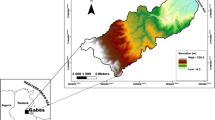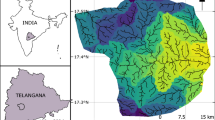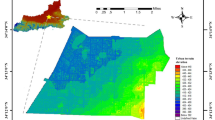Abstract
Despite the application of various methods to calculate uncertainty in flood vulnerability assessments, the challenge of uncertainty remains. The main purpose of this study was to establish the impact of uncertainty on flood risk anticipation. To this end, the real flood zone in Khuzestan region, southwestern Iran, was initially determined in 2019, and then compared with the 100-year flood, forecasted by competent authorities and modeled using the analytic hierarchy process (AHP) and the ArcGIS software. In this study, uncertainty in flood-induced vulnerability was also assessed via the AHP and the ArcGIS software to reveal its conformity with reality. Afterward, the digital elevation models (DEMs) and satellite imagery data coupled with the overlay of vulnerable/invulnerable areas were determined in the real flood. The results were subsequently compared with the 2019 real flood and the 100-year return, anticipated by the AHP-GIS model. The output revealed that 53% of the invulnerable areas had been inundated in total, leading to huge economic damage and surprising local people. Furthermore, the findings demonstrated that despite much effort, the applied models did not always correspond to reality. To predict the future and to minimize uncertainty, a scenario-based robust optimization approach or regret theory would be suggested to solve such problems.









Similar content being viewed by others
Data availability
Data and materials are not available online.
References
Al-Nasrawi AK, Kadhim AA, Shortridge AM, Jones BG (2021) Accounting for DEM error in sea level rise assessment within riverine regions; case study from the shatt al-arab river region. Environments 8(5):46
Antrop M, Van Eetvelde V (2017) Landscape perspectives: the holistic nature of landscape. Springer, Netherlands
Apte A (2010) Humanitarian logistics a new field of research and action. Found Trends® Technol Inform Op Manag 3(1):1–100
Atkinson PM, Foody GM (2002) Uncertainty in remote sensing and GIS: fundamentals. Uncertainty in remote sensing and GIS. A. P. M. and F. G. M., Wiley: 18
Bates PD, Dawson RJ, Hall JW, Horritt MS, Nicholls RJ, Wicks J, H. Mohamed Ahmed Ali Mohamed, (2005) Simplified two-dimensional numerical modelling of coastal flooding and example applications. Coast Eng 52(9):793–810
Beroya-Eitner MA (2016) Ecological vulnerability indicators. Ecol Indic 60(2016):329–334
Bhave AG, Conway D, Dessai S, Stainforth DA (2018) Water resource planning under future climate and socioeconomic uncertainty in the cauvery river basin in Karnataka, India. Water Resour Res 54(2):708–728
Bohloli A, Montazeri Namin M (2019) Evaluation of flood propagation in khuzestan province and effect of dams on flood control by numerical modeling. In: 15th Iranian National Hydraulic Conference. Qazvin, Iranian Hydraulic Society (In persian)
Bonakdari H, Zaji AH, Binns AD, Gharabaghi B (2019) Integrated Markov chains and uncertainty analysis techniques to more accurately forecast floods using satellite signals. J Hydrol 572:75–95
Boulomytis VTG, Zuffo AC, Imteaz MA (2019) Detection of flood influence criteria in ungauged basins on a combined Delphi-AHP approach. Op Res Perspect 6:100116
Brito MMD, Evers M, Almoradie ADS (2018) Participatory flood vulnerability assessment: a multi-criteria approach. Hydrol Earth Syst Sci 22:373–390
Copernicus Emergency Management Service. (2019). "EMSR352: Flood in Iran." Retrieved https://emergency.copernicus.eu/mapping/list-of-components/EMSR352.
Couclelis H (2003) The certainty of uncertainty: gis and the limits of geographic knowledge. Trans GIS 7(2):165–175
Crosetto M, Tarantola S (2001) Uncertainty and sensitivity analysis: tools for GIS-based model implementation. Int J Geogr Inf Sci 15(5):415–437
Das B, Pal SC, Malik S, Chakrabortty R (2019) Living with floods through geospatial approach: a case study of Arambag C.D. Block of Hugli District, West Bengal, India. SN Appl Sci 1(4):329
Dottori F, Martina M, Figueiredo R (2018) A methodology for flood susceptibility and vulnerability analysis in complex flood scenarios. J Flood Risk Manag 11(S2):S632–S645
Firpo S, Possebom V (2018) Synthetic control method: Inference, sensitivity analysis and confidence sets. J Causal Inference 6(2):20160026. https://doi.org/10.1515/jci-2016-0026
Fuchs S, Keiler M, Ortlepp R, Schinke R, Papathoma-Köhle M (2019) Recent advances in vulnerability assessment for the built environment exposed to torrential hazards: Challenges and the way forward. J Hydrol 575:587–595
Geological Survey and Mineral Exploration of Iran (2019) Flood map of Khuzestan province. Retrieved: https://gsi.ir/ahwaz/fa/page/1359/%D9%86%D9%82%D8%B4%D9%87-%D9%87%D8%A7
Halbert K, Nguyen CC, Payrastre O, Gaume E (2016) Reducing uncertainty in flood frequency analyses: A comparison of local and regional approaches involving information on extreme historical floods. J Hydrol 541:90–98
Huang K, Ye L, Chen L, Wang Q, Dai L, Zhou J, Zhang J (2018) Risk analysis of flood control reservoir operation considering multiple uncertainties. J Hydrol 565:672–684
Kardan N, Hassanzadeh Y, Arzanlou A (2018) 2D numerical simulation of urban floods using CCHE2D (case study: Aghghala City). Iranian Journal of Marine Technology 4(4):25–36
Khavazi K (2019) Agricultural damge due to 2019 Flood in Khoseatan, Tnews, Retrieved http://tnews.ir/news/a286176653152.html
Liu J, Shi ZW (2017) Quantifying land-use change impacts on the dynamic evolution of flood vulnerability. Land Use Policy 65:198–210
Lundgren M (2020) Dynamic vulnerability in the face of floods : Experiences from Mozambique. Independent thesis Advanced level (degree of Master (Two Years)) Student thesis
Lyu HM, Zhou WH, Shen SL, Zhou AN (2020) Inundation risk assessment of metro system using AHP and TFN-AHP in Shenzhen. Sustain Cities Soc 56:102103
Mazzorana B, Levaggi L, Keiler M, Fuchs S (2012) Towards dynamics in flood risk assessment. Nat Hazard 12:3571–3587
Ministry of Energy. (2017). "Khuzestan rivers discharge dataset." Minstry of Energy
Nachappa TG, Piralilou ST, Gholamnia K, Ghorbanzadeh O, Rahmati O, Blaschke T (2020) Flood susceptibility mapping with machine learning, multi-criteria decision analysis and ensemble using Dempster Shafer Theory. J Hydrol 590:125275
National Forest, Range and Watershed Management Organization of Iran (2019) Ahwaz 100ys Flood. National Forest, Range and Watershed Management Organization of Iran
Qi H, Altinakar MS (2011) A GIS-based decision support system for integrated flood management under uncertainty with two dimensional numerical simulations. Environ Model Softw 26(6):817–821
Qi Y, Wang Y, Hong J, Du S (2021) Additional reference height error analysis for baseline calibration based on a distributed target DEM in TwinSAR-L. Remote Sensing 13(14):2750
Rashidi R, B. Omidvar (2014) An analysis of natural hazards in khuzestan province. first national conference on geography, tourism, natural resources and sustainable development. Tehran, Iranian Institute
Shahid Chamran University of Ahvaz (2019) Khuzestan flood report. Shahid Chamran University of Ahvaz. Retrieved: https://scu.ac.ir/article/2792656
Singh P, Sinha VSP, Vijhani A, Pahuja N (2018) Vulnerability assessment of urban road network from urban flood. Int J Disaster Risk Reduct 28:237–250
Stefanidis S, Stathis D (2013) Assessment of flood hazard based on natural and anthropogenic factors using analytic hierarchy process (AHP). Nat Hazards 68(2):569–585
Tanaka T, Tachikawa Y, Ichikawa Y, Yorozu K (2019) An automatic domain updating method for fast 2-dimensional flood-inundation modelling. Environ Model Softw 116:110–118
Teng J, Jakeman AJ, Vaze J, Croke BF, Dutta D, Kim SJEM (2017) Flood inundation modelling: a review of methods, recent advances and uncertainty analysis. Environ Model Softw 90:201–216
Thapa S, Shrestha A, Lamichhane S, Adhikari R, Gautam D (2020) Catchment-scale flood hazard mapping and flood vulnerability analysis of residential buildings: the case of Khando River in eastern Nepal. J Hydrol: Regional Stud 30:100704
U.S. Geological Survey (2020) Landsat Satellite Images, (SRTM) 1 Arc-Second Global, accessed January 10, 2020, at URL https://earthexplorer.usgs.gov
Walter MJ, Cottrell E (2013) Assessing uncertainty in geochemical models for core formation in Earth. Earth Planet Sci Lett 365:165–176
Westerhoff L, Smit B (2008) The rains are disappointing us: dynamic vulnerability and adaptation to multiple stressors in the Afram Plains, Ghana. Mitig Adapt Strat Glob Change 14(4):317
Whitington J (2019) Anthropogenic rivers: the production of uncertainty in lao hydropower. Cornell University Press
Yang W, Xu K, Lian J, Bin L, Ma C (2018) Multiple flood vulnerability assessment approach based on fuzzy comprehensive evaluation method and coordinated development degree model. J Environ Manage 213:440–450
Yu D, Lane SN (2006) Urban fluvial flood modelling using a two-dimensional diffusion-wave treatment, part 1: Mesh resolution effects. Hydrol Process 20:1541–1565
Yuren D Jing D (1996) The study on stochastic models of rain storm──the study on stochastic simulation of storm flood system in a basin(V). China Knowledge Resource Integrated Database
Zhang Y, Wang Y, Chen Y, Liang F, Liu H (2019) Assessment of future flash flood inundations in coastal regions under climate change scenarios—a case study of Hadahe River basin in northeastern China. Sci Total Environ 693:133550
Zou Q, Zhou J, Zhou C, Song L, Guo J (2013) Comprehensive flood risk assessment based on set pair analysis-variable fuzzy sets model and fuzzy AHP. Stoch Env Res Risk Assess 27(2):525–546
Funding
The authors received no specific funding for this work.
Author information
Authors and Affiliations
Contributions
HD, HK, and AJ conceived and designed the research; HK and AJ designed and performed the experiments and analyzed the data; HK and AJ wrote and edited the manuscript; HD provided critical feedback and helped to shape the research.
Corresponding author
Ethics declarations
Conflict of interest
The authors have no conflict of interest to declare. All co-authors have seen and agree with the contents of the manuscript. The authors declare that they have no known competing financial interests or personal relationships that could have appeared to influence the work reported in this paper. We certify that the submission is original work and is not under review at any other publication.
Additional information
Publisher's Note
Springer Nature remains neutral with regard to jurisdictional claims in published maps and institutional affiliations.
Rights and permissions
About this article
Cite this article
Darabi, H., Kordani, H. & JamshidAbadi, A. Flood anticipation, reality, and uncertainty, the 2019 flood in Khuzestan, Iran. Nat Hazards 113, 365–381 (2022). https://doi.org/10.1007/s11069-022-05305-y
Received:
Accepted:
Published:
Issue Date:
DOI: https://doi.org/10.1007/s11069-022-05305-y




